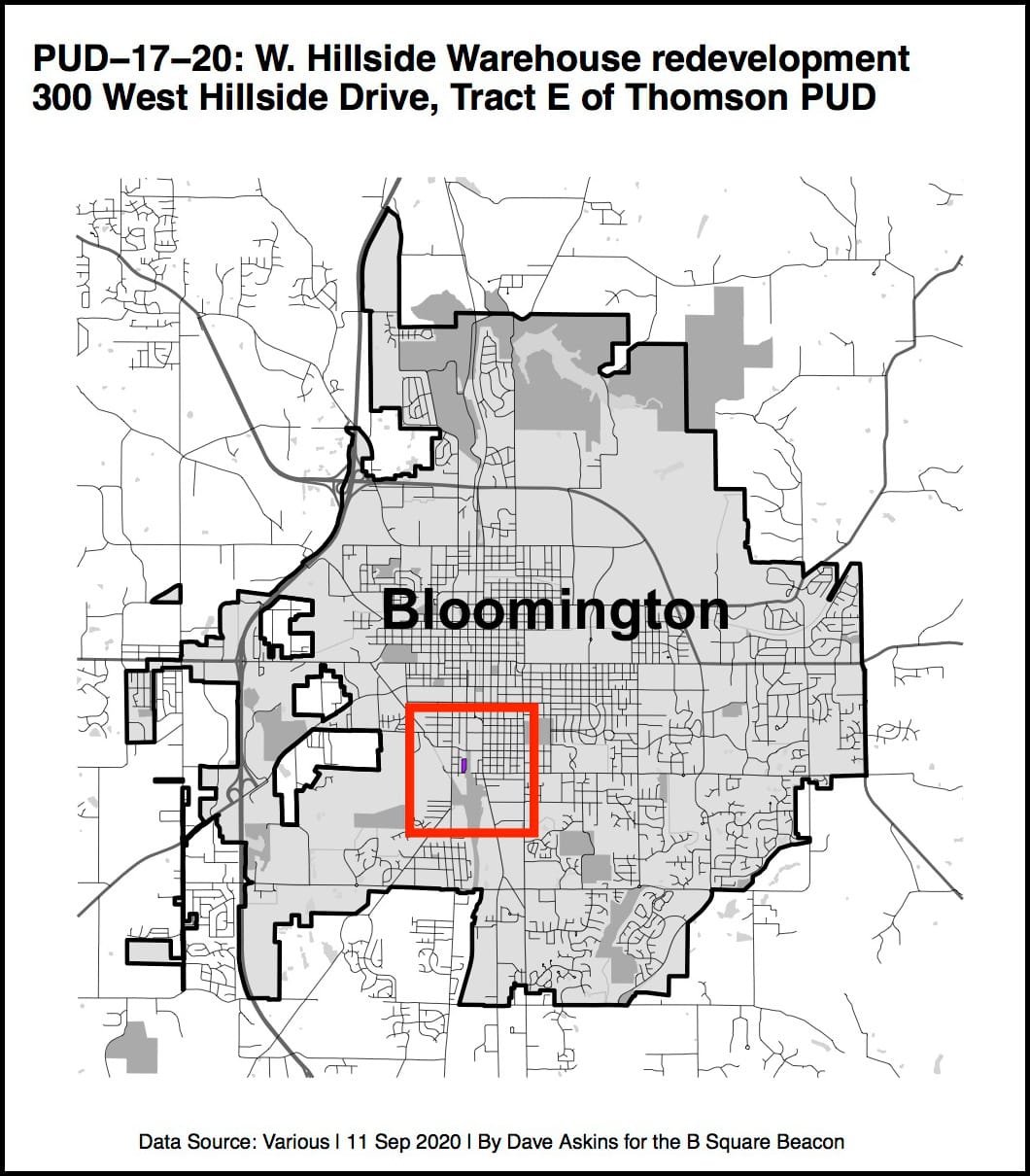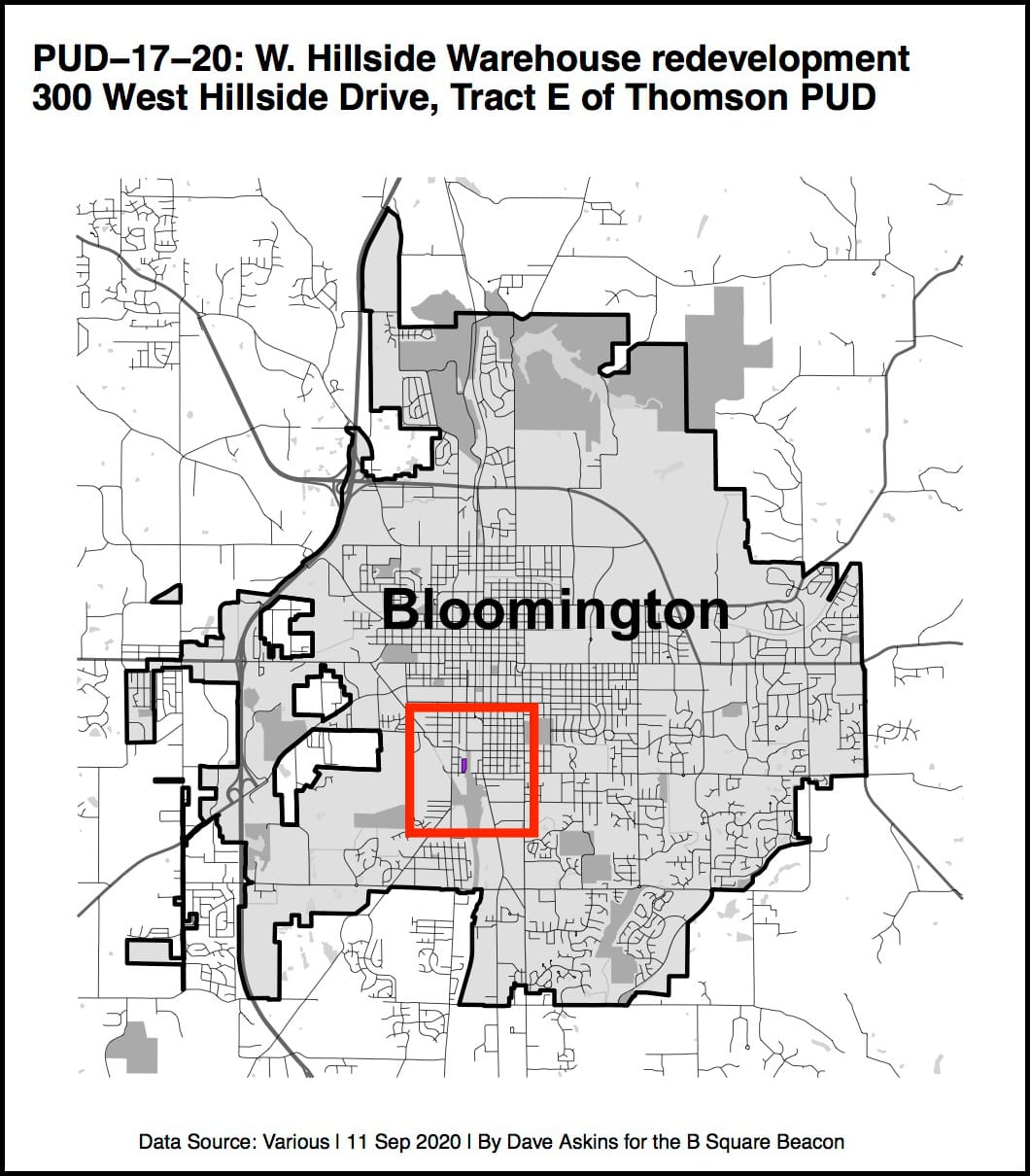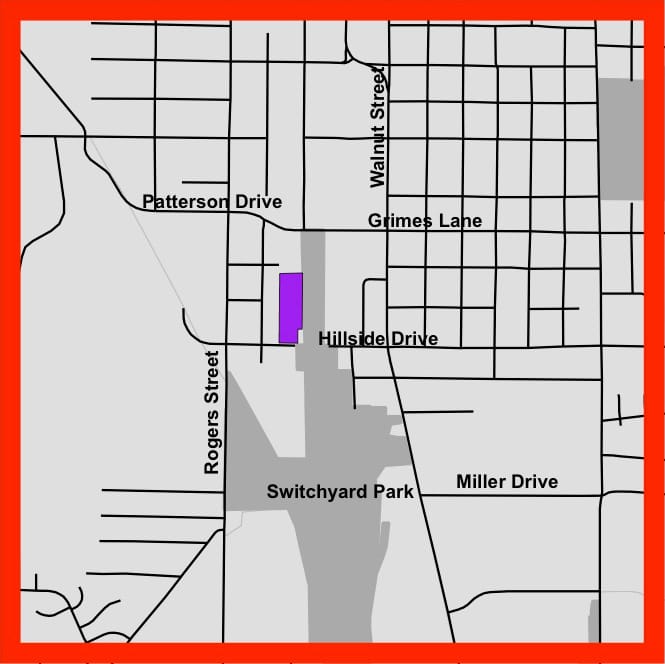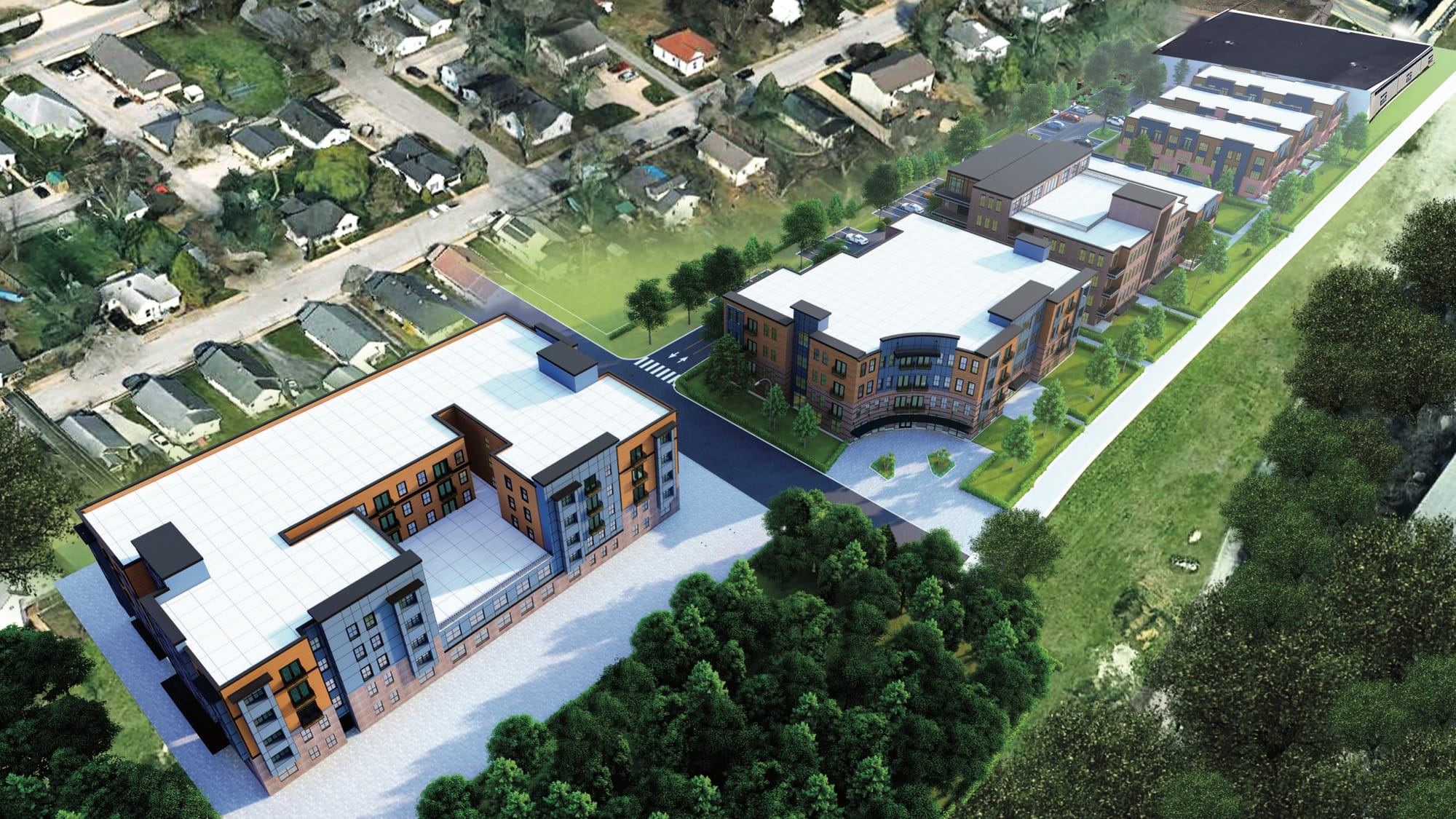Proposed redevelopment of warehouse across from new Bloomington park sets stage for debate on density and green space




The warehouse across the B-Line Trail from the pickleball courts in Bloomington’s new 65-acre Switchyard Park is the subject of a rezone request that landed in front of the city council last Wednesday.
The project associated with the proposed rezone would require the demolition of the southern two-thirds of the warehouse, which is the part controlled by McDoel Business Center owner Tom Brennan.
The associated project would construct seven buildings containing a total of 19 townhomes and 104 multi-family apartments.
Last week’s city council meeting was just the occasion for the first reading of the rezone. So it didn’t get any action from the city council other than a referral to the council’s land use committee.
The land use committee is chaired by councilmember Isabel Piedmont-Smith. She weighed in during public commentary at the plan commission’s early-January hearing on the requested rezone. That likely foreshadows at least some of the committee’s deliberations—on the question of greenspace.
Piedmont-Smith echoed concerns expressed by the city’s environmental commission about the amount of impervious surface that is now proposed under the rezone—up to 80 percent. The UDO standard for multi-family districts is 60 percent. Piedmont-Smith said during her remarks to the plan commission, “We are compromising on our principles—as far as preserving greenspace—with 80 percent. So, in that respect, I’m not in favor of the petition.”
On the land use committee’s agenda for this Wednesday is not just the rezone for the McDoel Business Center warehouse. The committee will be considering a rezone request from Bill Brown, for an 87-acre parcel in the south part of town.
A PUD is a kind of custom zoning, which includes its own custom development standards. The proposed rezone for the warehouse across from Switchyard Park would maintain the PUD designation, but use different development standards from the existing PUD.
That means the rezone is tied pretty closely to the proposed project, even though the city council won’t be passing judgment on the site plan.


A main sticking point for planning staff at the plan commission’s December meeting was the way the townhomes were proposed to be oriented to the park. As the city’s development services manager Jackie Scanlan put it, when she commented on the project renderings: “When you look down the sides of these buildings, you can tell that these are the sides of buildings, and we would prefer that they look like the front of buildings.”
The new renderings provided at the plan commission’s January meeting seems to satisfy the planning staff’s concerns.
The city’s planning staff relied to some extent on a review of the proposal done by Schmidt Associates, a consultant sometimes used by the planning department.
Even if the issue with the configuration of the townhome buildings had been resolved between December and January, two issues remained for the planning staff at the January meeting: impervious surface, or green space, and building height.
The vote at the plan commission’s December meeting was 7–1 with Israel Herrera dissenting. Chris Cockerham, a commercial real estate broker, recused himself from the deliberations and did not vote.
The owner’s proposed 100-percent maximum impervious surface area was reduced to 80 percent, by a condition of approval, required by the plan commission.
The concern from the city’s environmental commission (EC), which Piedmont-Smith had echoed during the January plan commission meeting is put this way in the EC’s letter, which recommends denial of the proposed rezone: “There is one design request that the commission cannot abide; the unreasonably reduced amount of greenspace. We cannot justify allowing such a change from Bloomington’s vetted regulations with nothing in return to benefit the community’s environmental footprint.”
Counterpoints came from the project’s architect, Doug Bruce with Tabor/Bruce Architecture & Design. He pointed to a 30-foot easement on the parcel that runs north to south—which could eventually provide a connection to Hillside Drive. Bruce said that he would not be able to plant anything in that easement.
Bruce described the current warehouse that stands on the parcel, “Basically, it’s 100 percent or 99 percent impervious surface right now, next to the largest green space in the city of Bloomington.”
Bruce added, “So, when this building, that’s an eyesore—sorry, Tom—comes down, there’ll be more green space there than you see now.”
The project now proposed by owner Tom Brennan is the result of some back-and-forth between the administration and neighborhood groups over the last couple years about the amount of hoped-for housing for the location. The possibilities ranged from single-family homes to just multi-family buildings for the whole parcel.
At the January plan commission meeting, a specific density issue for the proposal that was identified by the planning staff was the height of one of the buildings. From the staff memo to the plan commission: “The Department is concerned about the height of this building since it is closer to the neighborhood then the two other buildings of similar height located on the other parcel to the north.”
The memo notes that of the five stories, just three are for residential use. The other two floors are strictly for parking. The planning staff’s recommendation was that the building in question be be limited in height to four stories, or 50 feet.
The concern about height was addressed by the plan commission through a condition for approval that required a reduction in height from five to four stories. [Clarified March 10, 5:50 p.m.: The plan commission’s condition was described by senior zoning planner Eric Greulich at the March 10 city council land use committee meeting as requiring the fifth story to be stepped back. ]
During public commentary, Elizabeth Ash, a resident of the McDoel Garden neighborhood, which flanks the west side of the warehouse, weighed in against the project based on the building height. “You see how massive this is compared to the single- or two-level houses. It’s like this ogre over the neighborhood,” Ash said.
Ash continued, saying that residents of the new, taller buildings would be able to look into the backyards of the existing houses. “The scale is just too big for this little neighborhood,” Ash said.
The commercial neighbor who will be directly affected by the project is the owner of the northern third of the warehouse, Jefferson Shreve. He’s the owner of Storage Express, which occupies the warehouse space in that part of the building.
At the plan commission’s January meeting, Shreve sketched out a number of concerns. They included the engineering requirements for slicing off the warehouse’s southern two-thirds.
Shreve also talked about the unknowns, which included the developer, according to Shreve: “I don’t know who’s going to develop this project… My guesstimate would be maybe a north of $50 million undertaking. But I don’t think that’s in the wheelhouse of the petitioner.”
The connectivity of the proposed project, if his part of the building were eventually to be redeveloped, might cause the current proposal to be re-thought, Shreve said. “This project could become something of a do-over,” he said.
On the whole, though, Shreve was not there to object to the project: “I think if this is approved, it adds value to my property. And so I’m not speaking against it.”
The start time for the land use committee meeting on Wednesday (March 10) is 5:30 p.m.




Comments ()